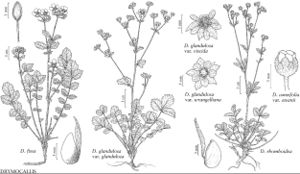Drymocallis rhomboidea
Monogr. N. Amer. Potentilleae, 203. 1898.
Caudex branches short. Stems ± tufted, 1.7–4.7 dm; base 1–3 mm diam., usually not septate-glandular. Leaves moderately to densely hairy; basal 5–12 cm, leaflet pairs 3; terminal leaflet obovate-elliptic, 1–2.5 (–3) × 1–2 (–2.5) cm, teeth single or double, 6–10 per side, apex obtuse to rounded; cauline 0–2, developed or reduced, leaflet pairs 2–3. Inflorescences 5–35-flowered, ± leafy, usually ± open, 1/3–2/3 of stem, wide, branch angles 15–60°. Pedicels 1–5 (proximal to 15) mm, predominantly short-hairy, usually not or sparsely, sometimes moderately, septate-glandular. Flowers opening narrowly; epicalyx bractlets linear-oblanceolate, 2–3.5 × 1 mm; sepals ± erect, 4–6 (–8) mm, apex obtuse; petals not overlapping, ± erect, cream-white, usually narrowly obovate, sometimes oblanceolate, 3–5 × 2–3 mm, usually ± shorter than sepals; filaments 1.5–3 mm, anthers 0.6–1 mm; styles slender, 1.5–2.5 mm. Achenes light reddish-brown, 1–1.2 mm. 2n = 14.
Phenology: Flowering Jun–Jul(–Aug).
Habitat: Dry slopes and outcrops in open forests
Elevation: 1200–2500 m
Discussion
Drymocallis rhomboidea is centered in the Siskiyou Mountains. It differs from D. campanulata in its smaller, cream-white petals and globular flowers; in addition, the vestiture is usually predominantly short-hairy, except in scattered California populations. Plants from Mount Ashland, the type locality, tend to have more congested, leafier inflorescences than plants found elsewhere in the range.
Selected References
None.
Lower Taxa
"thin" is not a number."wide" is not a number."dm" is not declared as a valid unit of measurement for this property.

